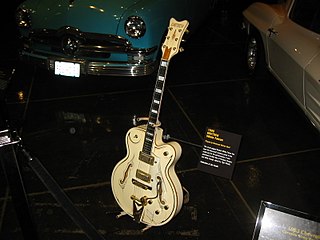
The Gretsch BST 1000 is a solid body electric guitar made between 1979 and 1981. It received the nickname "The Beast" from a Gretsch promotion distributed in 1979.

The Gretsch BST 1000 is a solid body electric guitar made between 1979 and 1981. It received the nickname "The Beast" from a Gretsch promotion distributed in 1979.
Two variations of the 1000 series exist although many features remain the same on both models. Some consistencies between the two models include a mahogany body and a bolt on maple neck. The first of the two guitars was made with dual chrome colored covered humbuckers and a white pickguard. "Gretsch" is written in cursive-like font running horizontal across the headstock when looking at the guitar sitting on a stand. It also has a flat fretboard similar to a classical guitar. The second model is also called the 1500 "but is still in the 1000 series as opposed to the 2000 and 5000 BST series". This model came stock with cream colored DiMarzio Super Distortion pickups with no covers and a black pickguard. The name "Gretsch" is written vertical across the headstock in classic Gretsch style writing featured on many other guitars and drums of the time. The BST 1000 and 1500 can be dated by removing the pickguard. Both guitars had serial and model numbers placed on a piece of paper by the volume and tone pots.


To date the guitar, there are five numbers in the serial number. The first one or two digits represents the month the guitar was made; 1 would represent January and 10 would be October. After the first set of (one or two) digits is a dash followed by another series of 4 digits. The first number after the dash represents the last digit of the year the guitar was made; 9 represents 1979, 0 represents 1980, and 1 would represent 1981. The last three numbers represent the number of guitars made that month including that guitar; 435 would mean the guitar is the 435th guitar made that month.
EXAMPLE: 10-9434 would be the 434th guitar made in October 1979. 4-1211 would be the 211th guitar made in April 1981.

Gretsch is an American company that manufactures musical instruments. The company was founded in 1883 in Brooklyn, New York by Friedrich Gretsch, a 27-year-old German immigrant, shortly after his arrival to the United States. Friedrich Gretsch manufactured banjos, tambourines, and drums until his death in 1895. In 1916, his son, Fred Gretsch Sr. moved operations to a larger facility where Gretsch went on to become a prominent manufacturer of American musical instruments. Through the years, Gretsch has manufactured a wide range of instruments, though they currently focus on electric, acoustic and resonator guitars, basses, ukuleles, and drums.

B.C. Rich is an American brand of acoustic and electric guitars and bass guitars founded by Bernardo Chavez Rico in 1969.

Hagström is a musical instrument manufacturer in Älvdalen, Dalecarlia, Sweden. Their original products were accordions that they initially imported from Germany and then Italy before opening their own facility in 1932. During the late 1950s, the company started making electric guitars and later amplifiers. The early guitars were heavily influenced by the accordion production and had a special look and feel. Hagström were the first company to mass-produce 8 string bass guitars as well as the first to build a guitar/synthesizer hybrid. The company ceased production in 1983. In 2004 the brand was resurrected and is now in production in China. In 2008 Hagström expanded their line of products and launched their own line of basses including a re-issue of their famous Hagström H8, an 8 string bass.

The Gibson Explorer is a type of electric guitar model by Gibson guitars, released in 1958. The Explorer offered a radical, "futuristic" body design, much like its siblings: the Flying V, which was released the same year, and the Moderne, which was designed in 1957 but not released until 1982. The Explorer was the final development of a prototype design that, years later, Gibson marketed under the name Futura.
The Fender Lead Series was produced by the Fender/Rogers/Rhodes Division of CBS Musical Instruments. The series comprised Lead I, Lead II, Lead III and Lead Bass models.
The Jackson Soloist is an electric guitar model introduced by Jackson Guitars in 1984, although prototypes were available before then. The design is a typical "superstrat"; it varies from a typical Stratocaster because of its neck-thru design; tremolo: Floyd Rose or similar, Kahler; or a fixed Tune-O-Matic; premium woods; a deeper cutaway at the lower horn for better access to the higher frets, and a sharper body with squared-off edges.

Tokai Gakki Company, Ltd., often referred to as Tokai Guitars, is a Japanese musical instrument manufacturer situated in Hamamatsu city, Shizuoka prefecture. Tokai is one of Japan's leading companies in the business. The company was founded in 1947 by Tadayouki Adachi and remains family-owned.

The Kay K-161 ThinTwin is an electric guitar made from 1952 to 1959, was one of the longest produced guitars by Kay Musical Instrument Company. The K161 Thin-Twin was commonly referred to as the "Jimmy Reed" guitar. Introduced not long after Gibson's Les Paul, the ThinTwin was a semi-hollow body guitar and larger than its name "thin" implied. The guitar's body was 2+3⁄4 inches (70 mm) deep. "ThinTwin" was a reference to the unique appearance of the dual pickups, having a very slim profile.

The Epiphone Casino is a thinline hollow body electric guitar manufactured by Epiphone, a branch of Gibson. The guitar debuted in 1961 and has been associated with such guitarists as Howlin' Wolf, George Harrison, John Lennon, Paul McCartney, Noel Gallagher, Keith Richards, Dave Davies, Brad Whitford, Shirley Manson, Paul Weller, The Edge, Josh Homme, Daniel Kessler, Brendon Urie, Gary Clark, Jr., Glenn Frey, John Illsley, and Peter Green.

Fender Contemporary Stratocaster electric guitars were produced by Fender Japan in the 1980s.

Burns Guitars London is an English manufacturer of electric guitars and bass guitars, founded by Alice Louise Farrell (1908–1993) and James Ormston (Jim) Burns (1925–1998) in 1959. The company was first named "Burns-Weill", then renamed "Ormston Burns Ltd". At its peak, in the 1960s, it was the most successful guitar company in England.
The Gibson Les Paul Custom is a higher-end variation of the Gibson Les Paul guitar. It was developed in 1953 after Gibson had introduced the Les Paul model in 1952.

The Gretsch White Falcon is an electric hollow-body guitar introduced in 1954 by Gretsch.

Greco is a Japanese guitar brand owned by the Kanda Shokai Corporation (in Japanese) 神田商会, a musical instrument wholesaler mostly known for being part of Fender Japan. Instruments manufactured with the name "Greco" are electric and acoustic guitars.
The Fender Bullet was an electric guitar originally designed by John Page and manufactured and marketed by the Fender Musical Instruments Corporation. It was first introduced as a line of "student" guitars to replace the outgoing Mustang and Musicmaster models.
The Epiphone Sheraton is a thinline semi-hollow body electric guitar. Though the Sheraton and all its variations were introduced under the ownership of the Gibson Guitar Corporation, Epiphone is the exclusive manufacturer.
Fender California Series electric guitars were produced by Fender in 1997 and 1998. The guitars were carved in California, shipped to Baja California Norte, Ensenada, Mexico for painting, then assembled in California.

Sigma Guitars is a guitar manufacturing brand originally released by C.F. Martin as a line of guitars at affordable prices to compete with the increasing number of imported guitars from Japan and elsewhere. The Sigma line was discontinued by Martin in 2007. The rights to the name were acquired by German company AMI Musical Instruments GmbH, which relaunched the brand with guitars being produced in China.
The Fender Telecaster, colloquially known as the Tele, is an electric guitar produced by Fender. Together with its sister model the Esquire, it was the world's first mass-produced, commercially successful solid-body electric guitar. Its simple yet effective design and revolutionary sound broke ground and set trends in electric guitar manufacturing and popular music.

The Fender Cabronita Telecaster is a class of guitars built by Fender Musical Instruments Corporation based on their Telecaster body shape. The name Cabronita is Spanish slang and roughly translates as little bastard or little devil. While retaining the shape and general feel of a Telecaster, they are a radical departure from the traditional electronics and sounds associated with the instrument. Like virtually all Telecaster submodels, they are labeled simply as a Fender Telecaster on the headstock logo, identifiable only by their features.